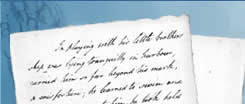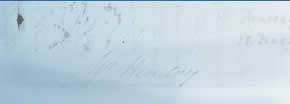| |
|
You are here:
Flinders
>
Browse the Documents
>
People (All)
|
| |
| People |
 |
All
A
B
C
D
E
F
G
H
I
J
K
L
M
N
O
P
Q
R
S
T
U
V
W
X
Y
Z
All
Back to document
| Flinders, Matthew
|
Born 16 March 1774 at Donington, Lincolnshire. Joined the Royal Navy in 1789 sponsored by Captain (later Admiral Sir) Thomas Pasley. Sailed with Captain William Bligh as Midshipman on the latter's second breadfruit expedition to the Pacific in 1791-93 in HMS 'Providence'. Took part in the naval action 'Glorious First of June' in 1794 in the 'Bellerophon' with Pasley. In 1795, he sailed as Master's Mate in the 'Reliance' under Captain Henry Waterhouse to the colony of New South Wales. With George Bass, surgeon of 'Reliance' (and Bass's boy servant William Martin) in 1796 he explored the reaches of Botany Bay in the first 'Tom Thumb', an 8-ft open boat. In 1798, in the 'Francis' he explored the Kent Group off Van Diemens Land (Tasmania). In command of the 'Norfolk' in 1798 he proved conclusively that there was a strait between the mainland and Van Diemens Land - and named it Bass's Strait after his great friend. Still in command of the 'Norfolk', he sailed northward in 1799 where he explored and charted areas around present-day Moreton and Hervey Bays in Queensland. Sailed back to England in 1800.
Appointed Lieutenant in command of the 'Investigator' (formerly the 'Xenophon') to lead a voyage of discovery around Terra Australis (Australia) 1801-03. Promoted to Commander in February 1801. Married Ann Chappelle on 17 April 1801. Successfully circumnavigated the continent of Australia and returned to Port Jackson in 1803. With the 'Investigator' condemned as unseaworthy, Flinders set sail in the 'Porpoise' to England in 1803 and was wrecked on uncharted reefs (now called Wreck Reef) off the Queensland coast. With 13 men he sailed back to Sydney in the ship's cutter to get help - a remarkable 1127 km (700 mile) journey. Set sail in another vessel - the 'Cumberland' - and rescued the survivors ('Rolla' and 'Francis' accompanied him to Wreck Reef). Continued to England but was forced to stop in December 1803 at Ile de France (Mauritius) for supplies and repairs. England was back at war with France and he was detained as a suspected spy for seven years. During this time he completed work on his charts and narrative and wrote a paper on a method of compensating for compass deviations caused by iron in a ship.
Released finally in 1810 (even though De Caen had received papers ordering his release in 1807), he returned to his family. Appointed Post Captain on his return in October 1810. Completed his experiments on compass deviations and his great work 'A Voyage to Terra Australis'. It was published the day he died, 19 July 1814, aged 40. Survived by his wife Ann and daughter Ann (born 12 April 1812). He was the first consistently to use the term 'Australia' and to confirm that the west (New Holland) and the east (New South Wales) were part of the one landmass. His charts became the basis of the Australian hydrographic record.
For additional information see the essay Flinders and the voyage of the 'Investigator' in the 'About Flinders' section of this site. |
Back to document
All
A
B
C
D
E
F
G
H
I
J
K
L
M
N
O
P
Q
R
S
T
U
V
W
X
Y
Z
All
|
|
|
|
Glossaries
People
Places
Vessels
Words
and phrases
All documents
List all documents
|



